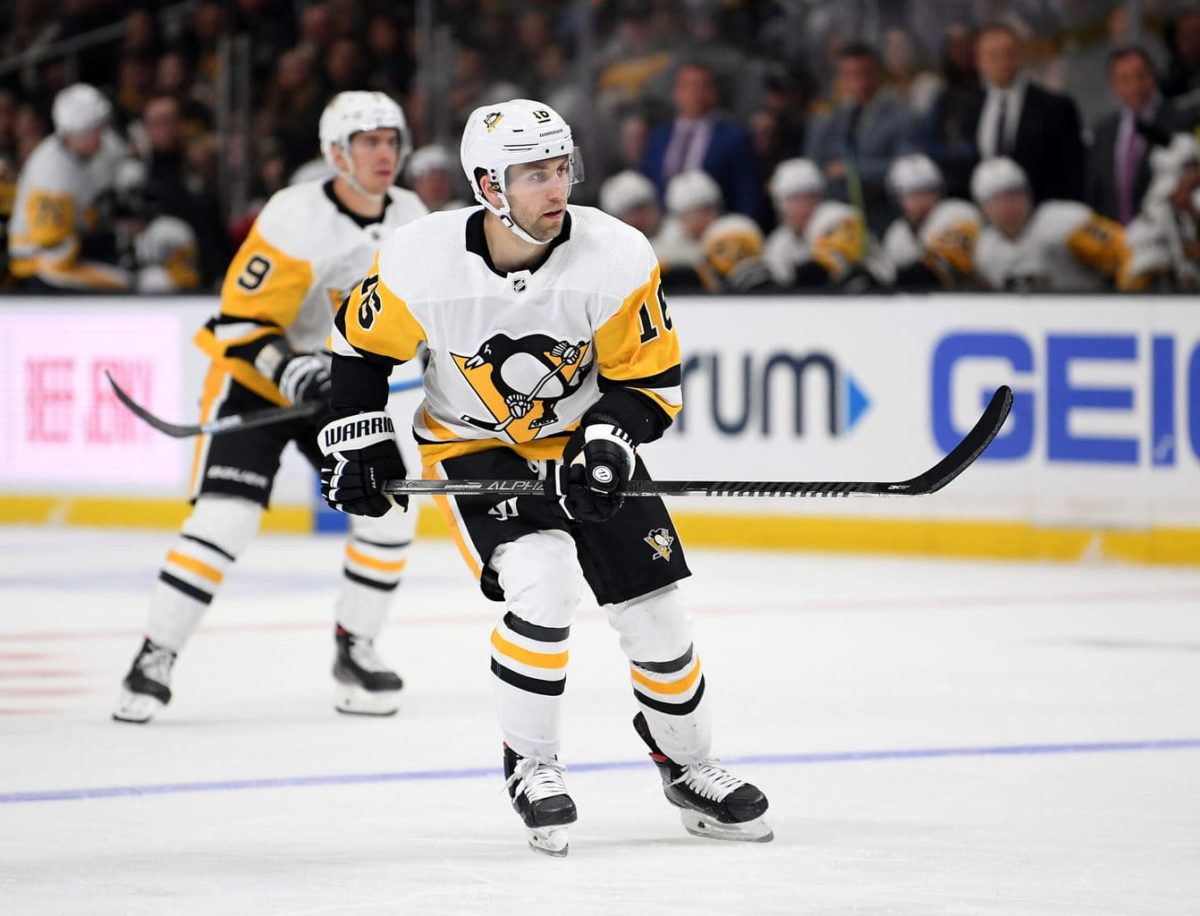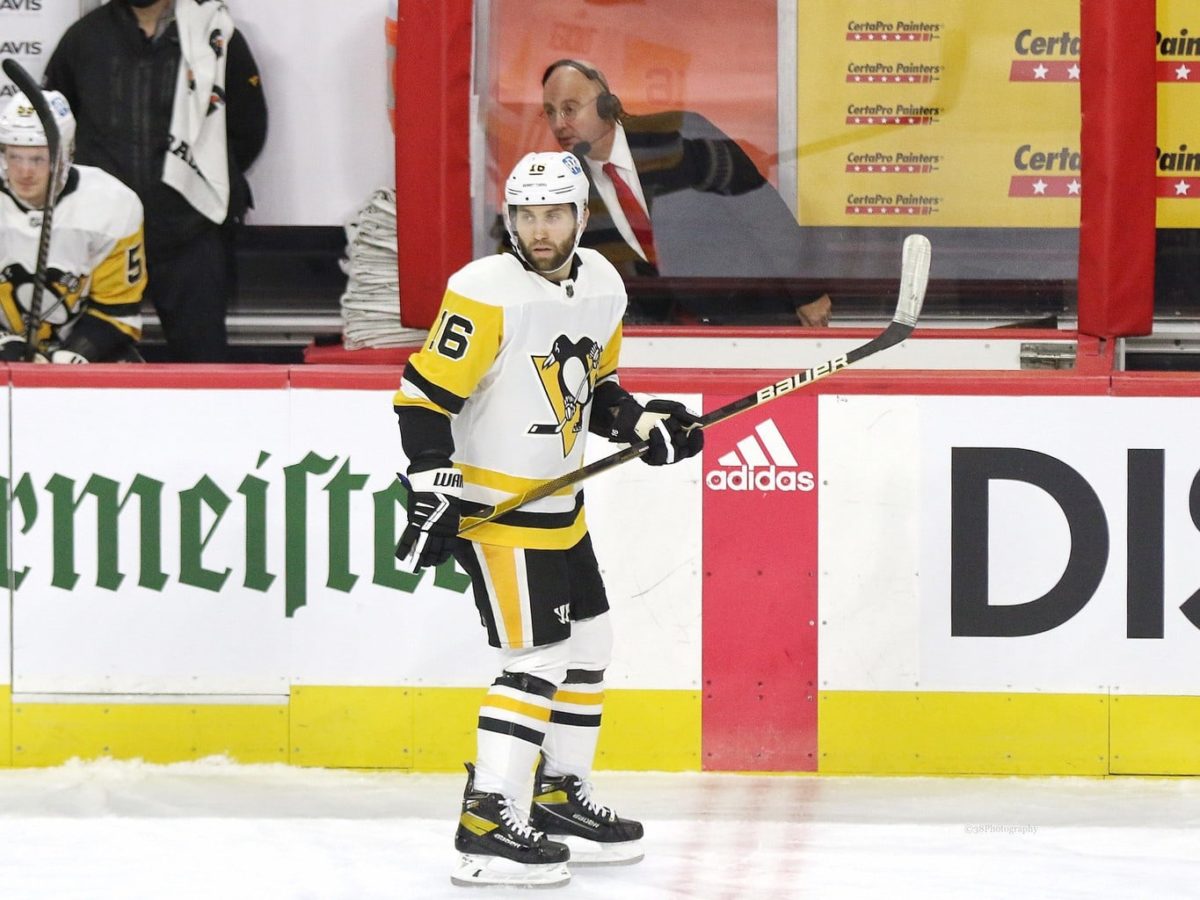Few players have caused as much internal strife for their fanbases this season as winger Jason Zucker has for the Pittsburgh Penguins. The owner of a hefty contract that pays him $5.5 million until the end of 2022-23 is tied down with an anchor of a no-trade clause, limiting management’s ability to part ways with a depreciated asset. Yet, despite his depressed scoring rate (11 points in 30 games), he is creating scoring opportunities at one of the highest rates of his career, which suggests that his counting stats are due for a massive swing in results in the second half of the 2021-2022 season. If the Penguins can refrain from pulling the trigger on a trade, they could reap the rewards of staying patient with a snake-bitten, but otherwise reliable, creator of offense. Let’s dig in.
Zucker a Frequent Subject of Trade Rumours
The unexpected emergence of cheaper forwards such as Evan Rodrigues ($1 million AAV) and Danton Heinen ($1.1 million AAV) makes Zucker an expendable asset at his current price point. Consequently, he’s spent much of the season acting as a lightning rod for trade rumors, with his outsized cap-hit serving as the catalyst for much of the dismay surrounding his play. The Penguins also have an eye on the future, with franchise legends in Evgeni Malkin and Kris Letang due for new contracts ahead of next season.
However, suppose either of the hallowed pair sacrifices a chunk of their salary. In that case, Zucker could be retained, a controversial decision that becomes all the more palatable if his production accelerates in the new year.

Further, the presence of like-minded wingers in Kasperi Kapanen and Bryan Rust – both featuring in trade rumors themselves – makes the trio’s skillset partially redundant, and one or more could leave for new horizons before next season as a result. On the other hand, management could view retaining Zucker as a deadline-type acquisition, banking on the possibility that more fortunate shooting luck revitalizes the downtrodden winger’s tenure in Pittsburgh. It’s an open secret that president of hockey operations Brian Burke loves earth-shattering trades, and beyond the obvious suspects, no Penguin should feel comfortable keeping their current postal code through the end of the season.
Zucker Generating High Volume of Offensive Opportunities
I’m sure several readers are groaning as I say this, but Zucker has been terrific this season, and his reduced point totals are more a product of rotten luck than any personal failings on his part. In fact, a glance at his underlying metrics shows that he is actually generating offensive opportunities at a higher rate than in recent seasons, despite what surface-level analysis may suggest. It requires a gritting of the teeth, but exercising patience appears to be the most prudent course of action for the Penguins’ executive group.
| 2019-20 | 2020-21 | 2021-22 | |
|---|---|---|---|
| Shots/60 | 6.63 | 6.17 | 9.96 |
| Individual Expected Goals/60 | 0.59 | 0.66 | 0.76 |
| Individual Scoring Chances/60 | 6.06 | 6.98 | 8.05 |
| Shooting Percentage | 11.36 | 14.81 | 2.99 |
Zucker’s individual metrics sparkle across the board and his offensive creation is at its most prolific in several seasons. Not only is he firing more shots on goal than in recent years, but his playmaking remains steady even as his individual scoring totals are in a noticeable decline.
His total (0.57 to 1.04) and primary (0.34 to 0.6) assists per-60-minutes have crept up from 2020-21, and the winger still exhibits a sharp nose for the net, fashioning the most rebound chances (0.89 per-60) since his last full season with the Minnesota Wild. Although he’s mired in a prolonged offensive slump, it’s not for lack of trying.
You May Also Like:
- Oilers: 2 Trade Targets From Penguins After Slow Start to 2024-25 Season
- NHL Rumors: Sabres, Penguins, Bruins, Oilers
- Pittsburgh Penguins’ Top Rivalries of the Crosby Era
- Islanders Trading For Penguins’ Beauvillier Could Save Season
- Red Wings Outlast Penguins for a 3-2 Overtime Win
Unfortunately, Zucker’s poor conversion extends to the power play where he’s registered a single point and accounts for only 16.7% of points accrued while he’s been on the ice. For comparison, his individual point percentage (IPP) hasn’t dipped below 70% with the man-advantage since the 2018-19 season. He is trudging through the worst season of his career from all angles. Betting on that to continue represents a short-sighted perception of how percentages always regress to the mean over a large enough sample, and hockey is not a unique sport in this respect. Accordingly, the Penguins should give up on him at their own peril.
Zucker Among the Most Snake-Bitten Forwards This Season
The game of hockey is often a rapidly fluctuating affair, and the element of luck figures prominently across single-game results. For that reason, a skater’s performance can also be held captive by the same whims of lady luck, with the final score often depicting a highly inaccurate portrayal of what is actually happening on the ice.
For example, let’s take Zucker’s statistical repertoire; the number that jumps out from the previous section is his five-on-five shooting percentage (SH%) of just under three percent, easily the worst mark of his NHL career. It’s that historic level of misfortune that hands him a spot on the podium for most snake-bitten skaters through the first half of 2021-22. As shown through data sourced by the analytically-driven JFresh, only Minnesota’s Kevin Fiala has experienced greater statistical adversity than Zucker this season.
Diving deeper into the numbers, it becomes clear that pronounced declarations of Zucker’s ineptitude are unfounded. Of the 68 forwards to have launched more shots than Zucker (81) this season, his 4.94 SH% in all situations sits second-last among that esteemed group. Only Dustin Brown of the Los Angeles Kings fares worse at 4.35%, demonstrating the full extent of Zucker’s scoring frustrations. Statistical outliers exist in any sample, but Zucker is clearly getting the short-end of the proverbial stick.
Further, among NHL forwards to have played at least 200 total minutes at five-on-five this season, Zucker rates favorably in terms of his per-60 paces for shots (30th), individual expected goals per-60 (132nd), and individual scoring chances (139th). He ranks ahead of established offensive studs such as Steven Stamkos, Jonathan Marchessault, and Brad Marchand in one or more of the categories above, each of whom commands a similar or greater salary than Zucker this year. Rate statistics can occasionally present wonky conclusions, but there’s something to be said about the elevated profile of Zucker’s statistical neighbors.

Also, astute readers should note that Zucker’s position relative to other NHL forwards puts him well within a second-line role. Additionally, his $5.5 million cap-hit is tied for 90th among forwards who have graduated from their entry-level deals. Factor in the considerable number of stars legally tied to rookie-scale contracts (Lucas Raymond, Jack Hughes, and Trevor Zegras, to name a few), and suddenly Zucker’s financial impact doesn’t appear as cataclysmic as parts of the fanbase would have you believe. That’s not to say more shouldn’t be desired of someone earning his salary, but a little perspective goes a long way in tempering inflated expectations.
Which Zucker Emerges in 2022?
Unfortunately, Zucker recently hit the injured reserve, temporarily stalling his potential return to form. However, even with strong underlying numbers, an increase in offensive production is not guaranteed. He could very well find himself on the outs in Pittsburgh if his point totals continue to stagnate. His contract devours a sizeable chunk of the Penguins’ cap room, and any moves at the trade deadline likely include him as a salary makeweight if his luck doesn’t rebound. If Pittsburgh keeps the faith, only time will tell if they made the correct decision, but one thing’s for certain – it won’t be based on an irrational gamble.
Data courtesy of Evolving-Hockey and Natural Stat Trick.